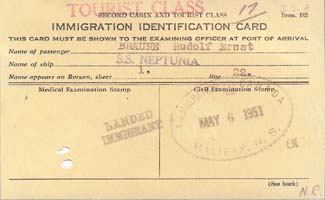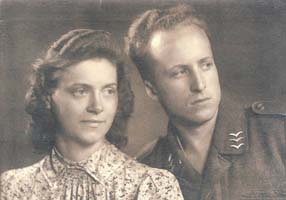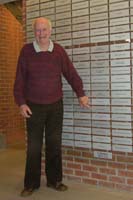Sobey Wall of Honour
Column
119
Row
22
My Story
By Rudolf E. Braune
On April 20th, 1951 at the age of 31, I boarded the S.S. Neptunia at Bremerhafen, Germany. I had left behind an ugly war, time spent in a Russian prison, and had an opportunity to become a 'guest of General Eisenhower' in the USA as a sought after engineer. My future wife had been badly wounded towards the end of the war and was unable to travel at that time, so I waited until an opportunity presented itself to immigrate to Canada. The situation looked fairly bleak in Germany at that time with the Americans and Russians carving up the country. I decided it was time to make my fortune elsewhere. My father and grandfather before me had spent their youth fighting wars and risking death. I figured a new country would offer me a new beginning. So, on that fateful day, I struck out on my own, leaving everything I knew behind: my parents, my relatives, my friends and my wife and baby daughter (who would join me four months later).
The ship looked small and I shared a cabin with others deep down near the waterline and driveshaft tunnel. The cost of the voyage was DM 600 or approximately $200 CDN. From Bremerhafen, our next stop was Le Havre where I observed many salvage crews raising sunken wartime ships. We crossed the English Channel and picked up some more emigrants at Southhampton where more signs of WWII were evident in the rubble of bombed buildings and more sunken ships.
Now the Neptunia entered the wide open Atlantic. It was not built to withstand the rough seas we encountered. The ten people eating at our dining room table quickly dwindled to four, even though the food was very good and the Greek crew was outstanding. Sea sickness was a problem for many. The generators stopped a few times and the water pressure was very low. I would take a shower around midnight when the pressure seemed stronger, but even then I had to move forward and backward to catch the weak dribbles of water coming from the showerhead. In the middle of the ship I noticed that the walls and floor sloped downward at one spot and I hoped that the ship would not break apart in the rough sea.
Because of the bad weather we spent most of our time inside the ship. I played a lot of chess with a young woman who loved to play chess. She had brought along a chess game that had chess figures with pegs that fit into holes in the chess board; otherwise we could not have played during the stormy crossing. She was kind enough to pay for drinks, I suppose as a way of saying thank-you for playing chess with her. As it was, I did not have any spare money to spend on the ship anyway. I only had the odd conversation with other passengers; most of them were seasick and stayed in their cabins.
On the 5th of May, 1951 we arrived in Halifax. The ship remained anchored in the harbour for the night. We all stood on the deck and gazed at the city lights wondering if we made the right decision to come to this new homeland.
The next morning, the 6th of May, we stepped onto Canadian soil. Our bags were unloaded and the immigration officers began their processing. I was cleared in no time and one of the officers asked me to help translate. I was surprised that my high school English was good enough to help him translate. Among the Germans who were cleared, there was a former German prisoner of war, who spent his time in a Bowmanville prison camp. He was released with a friendly "thank-you". By now I was feeling much better, especially because my English language skills seemed adequate.
A train took us to Toronto. We arrived there at 11:00 p.m. that night. The next morning while I was in a German grocery store buying some food, the store owner (knowing that I desperately needed a job and was willing to do just about anything) mentioned to a contractor who had come into the store, that he had a carpenter for him. On the spot I had my first job that paid $1.00 an hour plus overtime. Four months later, I was project engineer with a consulting firm. This coincided with the arrival of my wife and young daughter from Germany. In no time, I owned my own house and started my own company. My family had also grown to include two daughters and eventually a grandson. Things could not be better.
What a wonderful country!


